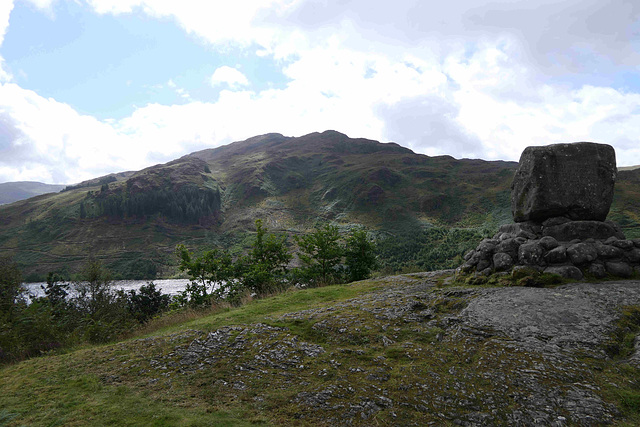Location
Lat, Lng: 55.092785, -4.483470
You can copy the above to your favourite mapping app.
Address: Bargrennan, Wigtownshire, Scotland
You can copy the above to your favourite mapping app.
Address: Bargrennan, Wigtownshire, Scotland
See also...
Keywords
Authorizations, license
-
Visible by: Everyone -
All rights reserved
-
30 visits
Battle of Glen Trool


Robert the Bruce had been crowned King of Scots after being involved in the killing of John Comyn, a rival and one of the most powerful men in Scotland. Robert the Bruce's claim to the Scottish throne led to a war between King Robert and King Edward I and his allies the Comyns and the MacDougalls.
After his defeat at the Battle of Dalrigh in 1306 King Robert disappeared from the historical record for a number of months. It wasn't until the spring of 1307 that he made a reappearance, landing in the south-west of Scotland with soldiers recruited, for the most part, from the Macdonald controlled Isles. He came ashore in his own earldom of Carrick, where he could expect to command a large degree of local support.
King Robert managed to establish a firm base in the area. An early success came with a raid on an English camp. The English received intelligence that his enemy was encamped at the head of Glen Trool.
This was a difficult position to approach, for the loch takes up much of the glen, with only a narrow track bordered by a steep slope. King Robert made effective use of the terrain to attack.
As the English approached up the defile, called by the locals the "Steps of Trool", they were forced to proceed single file. At a given signal, King Robert´s men pushed the wall of boulders down the slope. The narrowness of the path prevented support from either the front or the rear. Without room to maneuver, many of the English below were killed, and the rest withdrew.
Bruce's Stone is a boulder commemorating King Robert's victory. In 1929, on the 600th anniversary of Bruce's death, it was placed high above the northern shore of Loch Trool, from where, legend has it, he had commanded the ambush that took place on the Steps of Trool on the other side of the loch.
After his defeat at the Battle of Dalrigh in 1306 King Robert disappeared from the historical record for a number of months. It wasn't until the spring of 1307 that he made a reappearance, landing in the south-west of Scotland with soldiers recruited, for the most part, from the Macdonald controlled Isles. He came ashore in his own earldom of Carrick, where he could expect to command a large degree of local support.
King Robert managed to establish a firm base in the area. An early success came with a raid on an English camp. The English received intelligence that his enemy was encamped at the head of Glen Trool.
This was a difficult position to approach, for the loch takes up much of the glen, with only a narrow track bordered by a steep slope. King Robert made effective use of the terrain to attack.
As the English approached up the defile, called by the locals the "Steps of Trool", they were forced to proceed single file. At a given signal, King Robert´s men pushed the wall of boulders down the slope. The narrowness of the path prevented support from either the front or the rear. Without room to maneuver, many of the English below were killed, and the rest withdrew.
Bruce's Stone is a boulder commemorating King Robert's victory. In 1929, on the 600th anniversary of Bruce's death, it was placed high above the northern shore of Loch Trool, from where, legend has it, he had commanded the ambush that took place on the Steps of Trool on the other side of the loch.
- Keyboard shortcuts:
Jump to top
RSS feed- Latest comments - Subscribe to the comment feeds of this photo
- ipernity © 2007-2025
- Help & Contact
|
Club news
|
About ipernity
|
History |
ipernity Club & Prices |
Guide of good conduct
Donate | Group guidelines | Privacy policy | Terms of use | Statutes | In memoria -
Facebook
Twitter











Sign-in to write a comment.